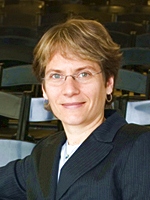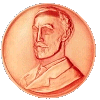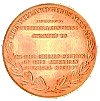
Presented by the Chicago Section
of the American Chemical Society


| Presented by the Chicago Section of the American Chemical Society | 
|
|---|
| Gibbs Medal Awardee: |

|
|---|---|
| Carolyn R. Bertozzi | |
T.Z. and Irmgard Chu Distinguished Professor of Chemistry and Professor of Molecular and Cell Biology University of California, Berkeley “Chemistry in Living Systems: Shedding Light on Glycans” |
Date: Friday, May 9, 2008 Location: Carriage Greens Country Club
8700 Carriage Greens Drive,
Darien, IL 60561
6:00 pm Reception ( hors-d’oeuvres and both champagne punch and non-alcoholic punch )
7:00 pm Dinner
8:30 pm Presentation
Introducing Professor Bertozzi: Cynthia Jameson, Professor, University of Illinois at Chicago, and Gibbs Juror
Presentation of the medal: Thomas Lane, President-Elect, American Chemical Society
Cost: $45.00 for members of ACS and their guests, $47.00 for non-members,
$22.50 for students or unemployed

| The History of the Willard Gibbs Award | 
|
|---|
The Citation:
For her studies of cell surface glycosylation pertinent to disease states; For profiling changes in cell surface glycosylation associated with cancer, inflammation and bacterial infection; and exploiting this information for development of diagnostic and therapeutic approaches; and for developing nanoscale technologies for probing cell function, and medical diagnostics.
A majority of cell surface and secreted proteins are posttranslationally modified by the addition of glycans. These complex structures can provide information regarding the state of health of cells or organisms. Indeed, changes in the structures of protein- and cell surface-associated glycans are a hallmark of many cancers, chronically inflamed tissues, and microbial infections. The ability to probe glycosylation in living systems may therefore reveal new biomarkers of disease and provide new avenues for diagnostic imaging.
We are developing chemical technologies for visualizing glycans in living systems. As products of secondary metabolism, glycans are constructed from simple monosaccharide precursors. We exploit these metabolic pathways to incorporate bioorthogonal chemical reporters into glycans. The chemical reporters comprise small functional groups, such as the azide, that can be detected by covalent reaction with highly selective probes. New chemical reactions have been developed for this purpose, such as the Staudinger ligation with phosphines and strain-promoted [3+2] cycloaddition with functionalized cyclooctynes. Applications of the technique to the identification of cancer-associated glycan biomarkers and noninvasive imaging are currently being pursued.
Biographical Sketch of Professor Carolyn R. Bertozzi:
Carolyn Bertozzi is the T.Z. and Irmgard Chu Distinguished Professor of Chemistry and Professor of Molecular and Cell Biology at UC Berkeley, an Investigator of the Howard Hughes Medical Institute, and Director of the Molecular Foundry, a nanoscience institute at the Lawrence Berkeley National Laboratory. She completed her undergraduate degree in Chemistry from Harvard University in 1988 and her Ph.D. in Chemistry from UC Berkeley in 1993. After completing postdoctoral work at UCSF in the field of cellular immunology, she joined the UC Berkeley faculty in 1996.
Prof. Bertozzi’s research interests span the disciplines of chemistry and biology with an emphasis on studies of cell surface glycosylation pertinent to disease states. Her lab focuses on profiling changes in cell surface glycosylation associated with cancer, inflammation and bacterial infection, and exploiting this information for development of diagnostic and therapeutic approaches. In addition, her group develops nanoscience-based technologies for probing cell function and for medical diagnostics.
Directions and Map to the Carriage Greens Country Club
- Caesar Salad
- a choice of:
- Seared Medallions of Beef with Burgundy Reduction Sauce, or
- Broiled Atlantic Salmon with Bearnaise Sauce, or
- Pasta Primavera
- Twice Baked Potato
- Whole Baby Green Beans
- Peach Cobbler
- Wine